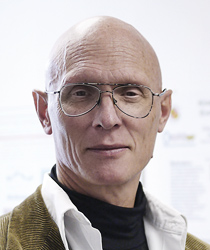
Phaneuf, Ray
Member, Laboratory for Physical Sciences
Fellow, APS
Maryland Energy Innovation Institute
EDUCATION
Ph.D., University of Wisconsin—Madison, 1985
BACKGROUND
Professor Ray Phaneuf joined UMD’s Department of Physics in 1985, where he used electron diffraction to study phase transformations on stepped Si(111) surfaces, resulting in the identification of a thermodynamically driven faceting associated with the formation of the (7x7) reconstruction. In 1989 he visited Ernst Bauer’s group in Clausthal, Germany, using low energy electron microscopy (LEEM) to image this faceting in real time. In 2000 he joined the Department of Materials Science and Engineering, and began studies of directed self-organization during growth and sublimation on semiconductor surfaces, using lithographic patterning. He was a founding member of the UM-MRSEC. In 2006 he was a visiting professor at the National Nanotechnology Laboratory, in Lecce, Italy. He is the founding director of the Interdisciplinary Minor in Nanoscience and Technology at the UMD. He is the author of more than 80 papers in archival journals, and has given over 40 invited talks on his work in the U.S., Europe and Japan. He was named the Laboratory for Physical Sciences Faculty Researcher of the year in 2002. In addition to MSE, he has affiliate positions in Physics and the Department of Electrical and Computer Engineering. His current research is in the fields of directing self-assembly of nanostructures at the mesoscale, plasmonics, and the application of nanotechnology to the conservation of cultural heritage.
Professor Phaneuf currently teaches or has taught the following courses:
- ENES 100: Introduction to Engineering Design
- ENMA 181: Introduction to Nanomaterials Seminar
- ENMA 300: Introduction to Materials and Their Applications
- ENMA 471: Diffusion, Kinetics and Phase Transformations
- ENMA 490: Materials Design: Capstone Design Course
- ENMA 698T: Nanotechnology Characterization
For a complete list of publications, please visit Professor Phaneuf's web site
- “Characteristic Length Scales In Evolution Of Patterned Step Structure On Vicinal Si(111) Surface During High Temperature Annealing”, H-C. Kan, T. Kwon and R. J. Phaneuf, Physical Review B 77, 205401-1,-6 (2008)
- “Fluorescence Enhancement from Size-selected Nanoparticles: The Role of an Active Substrate Substrate”, S.-H. Guo, S.-J. Tsai, H.-C.Kan, D.-H. Tsai, Michael R. Zachariah, and R. J. Phaneuf, Advanced Materials, 20, 1424-1429 (2008)
- “Near-surface modification of polystyrene by Ar+: Molecular dynamics simulations and experimental validation”, J. J. Végh*, D. Nest, D. B. Graves, R. Bruce, S. Engelmann, T. Kwon, R. J. Phaneuf, G. S. Oehrlein, B. K. Long and C. G. Willson, Applied Physics Letters 91, 233113-1,-3 (2007)
- “Plasma-surface interactions of model polymers for advanced photoresists using C4F8 /Ar discharges and energetic ion beams”, S. Engelmann, R. L. Bruce, T. Kwon, R. Phaneuf, G. S. Oehrlein*, Y. C. Bae, C. Andes, D. Graves and D. Nest, E. A. Hudson, P. Lazzeri, E.Iacob, and M. Anderle, Journal of Vacuum Science and Technology 25, 1353-1364 (2007)
- “Spatial and Size-Resolved Electrostatic-Directed Deposition of Nanoparticles on a Field-Generating Substrate: Theoretical and Experimental Analysis”, D.-H. Tsai, T. Hawa, H.-C. Kan, R. J. Phaneuf, and M. R. Zachariah, Nanotechnology 18, 365201-36510 (2007)
- “Transient Roughening Behavior and Spontaneous Pattern Formation during Plasma Etching of Nanoporous Silica”, T. Kwon, H.-C. Kan, G. S. Oehrlein, and R.J. Phaneuf, Nanotechnology, 18, 055305-055309 (2007)
- “Temperature-Driven Change in the Unstable Growth Mode on Patterned GaAs(001)”, T. Tadayyon-Eslami, H.-C. Kan, L. C. Calhoun and R. J. Phaneuf, Physical Review Letters 97, 126101-1,-4 (2006)
- “Evolution of Patterned GaAs(001) during Homoepitaxial Growth: Size vs. Spacing,” H.-C. Kan, R. Ankam, S. Shah, K.M. Micholsky, T. Tadayyon-Eslami, L. Calhoun, and R. J. Phaneuf, Phys. Rev. B 73, 195410-1,-8 (2006).
From the Chesapeake Bay to Deep Space: Innovating for the Public Good
More than 800 Clark School Seniors Present Projects to Tackle Real-World Problems at the 2025 Capstone Design ExpoSeven Current and Former Maryland MSE Students to Attend 73rd Lindau Nobel Laureate Meeting
The scholars will travel to Lindau, Germany in late June for a week-long discussion spanning the future of physics.MSE Students Selected as Finalists for the 2017 Collegiate Inventors Competition
Stretchable Silicon Photovoltaics is a new design for silicon solar cells.Ph.D. Candidate Miriam Hiebert Wins Smithsonian Fellowship
Award will allow Hiebert to extend her work at the Museum Conservation Institute.Engineering the Preservation of Cultural Heritage
Mimi Hiebert first became fascinated with studying and preserving antiquities thanks to an Egyptian mummy named “Tia.”Prof. Ray Phaneuf Appointed Acting Chair of Materials Science and Engineering
Professor Robert M. Briber named Clark School Associate Dean for Research.New Software Will Enhance Materials Science and Engineering’s Undergraduate Program
UMD wins one of six computational design toolkits from ASM International.Vote Now! Materials Video Enters Thinkable Competition
»Marquardt showcases conservation work in pursuit of $5K Open Innovation Award.Museum Conservation Research Wins Top Prizes in International 3-Minute Thesis Competition
Amy Marquardt uses nanotechnology and materials science to design protective coatings for silver art, artifacts.Vote Now! Materials Grad Student is Finalist in 3 Minute Thesis Competition (VIDEO)
Amy Marquardt uses nanotechnology to protect silver art and artifacts.2014 Dean's Student Research Awards Announced
Graduate students recognized for high quality engineering researchUsing Materials Science and Engineering to Save Priceless Artifacts
Graduate student Amy Marquardt wins CIC-Smithsonian Fellowship.Six graduate students participating in UMD-Trento research exchange
The program is part of a broad partnership between Maryland and Trento, Italy.MSE Professors to Present Historical Preservation Work at Smithsonian-UMD Celebration
Livingston, Phaneuf will discuss preservation of stone and metal.Materials Scientists, Conservators Join Forces
Team develops nanometers-thick, protective coatings for silver art, artifacts.Marquardt Studies Patinas at Smithsonian Institution
Microscopy, spectroscopy and microanalysis used to analyze bronze art, preserve sculpture.Five Elevated to Full Professor
Clark School's Adomaitis, Ghodssi, Phaneuf, Sandborn and Takeuchi promoted."Nature-Made" Computers
With a little prodding from engineers, nature can produce computer components.American Physical Society (APS)
- Fellow, American Physical Society